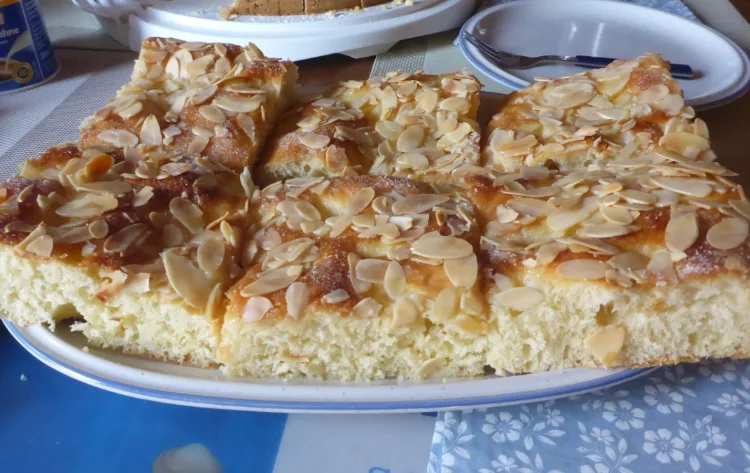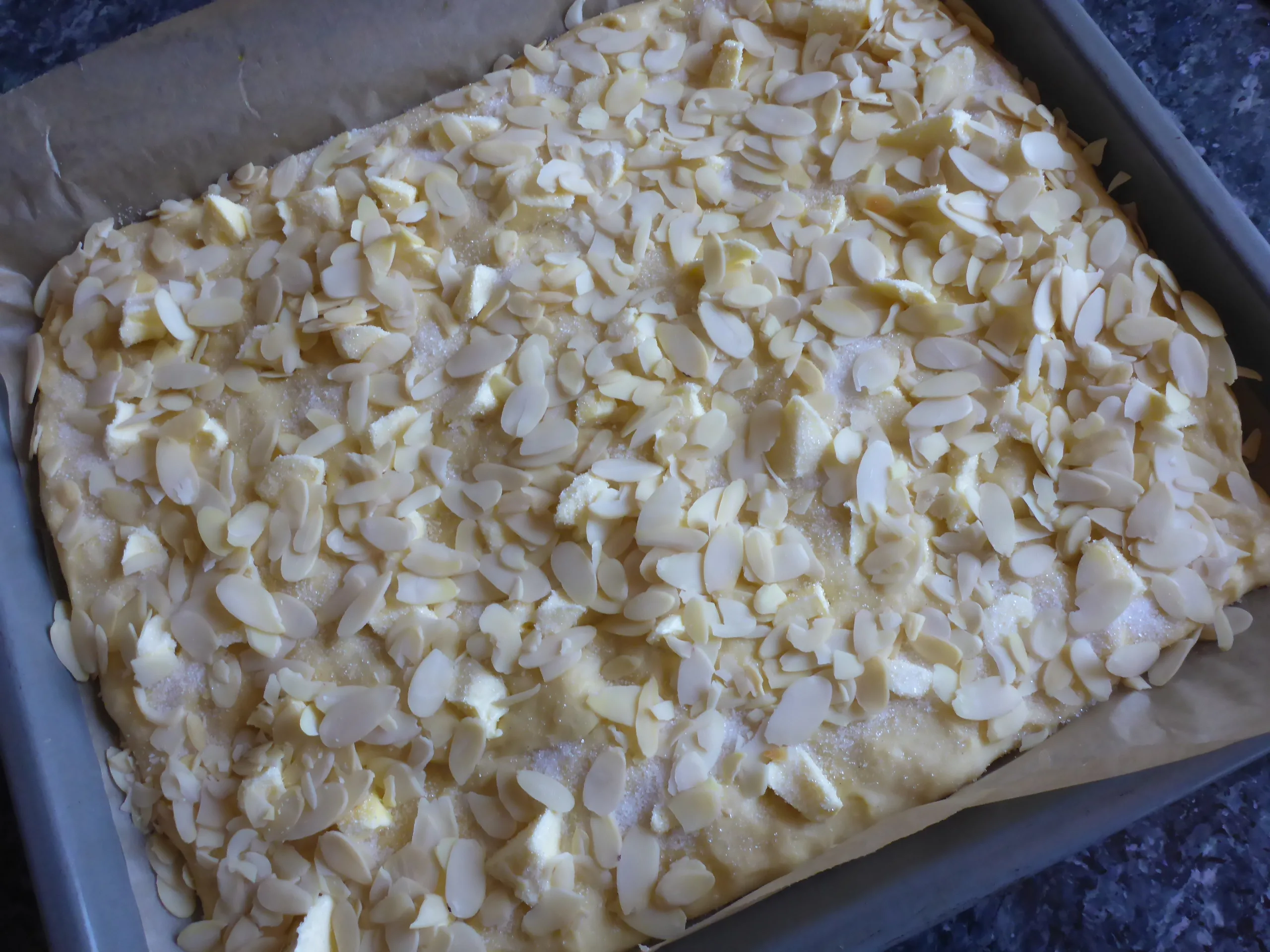Diesen Beitrag gibt es auch auf: Deutsch
Loaded with butter, this German butter cake aka. Butterkuchen with the right amount of sweetness is soft, fluffy, and so delicious.

Butterkuchen (literally means butter cake), is an easy to follow, fluffy, moist even on the third day and gloriously delicious German style butter cake with an amazing buttery vanilla flavor.
The Butterkuchen is made with a sweet yeast dough that rises twice, before it’s topped with almond flakes, butter, and sugar. Immediately after baking, whipping cream is poured on the hot cake. This makes the cake extra moister.

I know lots of people feel intimidated by baking with yeast. But making a yeast dough is easier than you think. Just follow this straightforward German butter cake recipe and I can guarantee you will have success with it.
What you’ll need to make German butter cake
- 80 g (2.8 oz/ ½ cup – 2 tablespoons) sugar
- 225 ml (7.6 fl.oz/ 1 cup – 1 tablespoon) milk
- 500 g (17.6 oz/ 4 cups + 2 tablespoons) plain flour (all-purpose flour)
- ¼ teaspoon salt
- 2 medium eggs, room temperature
- 85 g (about 3 oz/ about 1/3 cup/) butter plus extra for greasing the baking
- 4 teaspoons dry yeast (11 g/ about 0.39 oz)
- 2 tablespoons sunflower oil plus extra to grease the hands
- About 2 teaspoons vanilla bean paste
* Vanilla: This recipe calls for vanilla bean paste, but feel free to use seeds from one vanilla bean, about 1 teaspoon vanilla extract or about 2 tablespoons vanilla sugar. Just reduce the amount of sugar if you’re using vanilla sugar.

For the topping
- 50 g (about 1.8 oz/ ¼ cup) sugar
- About 130 g (4.6 oz/ 1/2 cup + 1 tablespoon) butter, cold
- 100 g (3.5 oz) almond flakes
- 200 ml (about 6.8 fl.oz/ ¾ cup + 1 tablespoon) heavy cream (whipping cream)

How to make German butter sheet cake with almond flakes and cream
How to make sweet yeast dough with dry yeast
Warm milk in the microwave for a few seconds. You just want the milk to be lukewarm and not hot. Next, put the flour into a large bowl and make a well in the middle. Then pour half of the milk into the center of the flour.
Add about 1 tablespoon sugar (from the 80 g (2.8 oz/ ½ cup – 2 tablespoons) sugar) and yeast to the well. Stir well and let the mixture stand for 10 minutes.
In the meantime, put the butter in the remaining milk in the jar and melt in the microwave. Stir occasionally until butter has melted. You could also use a pot and warm the milk on the stove. in a jar. Then let the butter mixture cool.

Next cover the yeast with flour, then add eggs, salt, vanilla, and the remaining sugar. Start mixing, while adding the lukewarm milk – butter mixture slowly. Add sunflower oil while the dough is busy kneading. Knead the dough very well.

Knead and rise the dough
Now knead the dough very well. I normally knead my dough like this: If I’m kneading it with the hand mixer with dough hooks, I knead the dough for about 8 minutes at low speed and then for 5 minutes on medium high speed.
With the kitchen machine (stand mixer) I knead the dough for 7 minutes at low speed (speed 1, on Bosch kitchen machine) and for 3 more minutes at medium high speed (speed 3). With the hands, I knead the dough for about 10 to 12 minutes.
If you’re using a heavy-duty kitchen machine, please knead your dough for maximum 7 minutes in total. Otherwise, you will be overworking the dough.

Let the dough rise
Without removing the dough from the bowl, shape it into a ball (it doesn’t have to be perfect). Cover the bowl with cling film and then with kitchen towel. Let the dough rise for about 1 ½ hours at room temperature.

Pull out the dough into the baking dish and let rise
In the meantime, rub a baking dish with butter and line with a parchment paper. I used a 45×37 cm (17.72 x 14.57 inch) baking sheet. After the first rise, tip the dough in the middle of the baking dish and rub your hands with a few drops of sunflower oil.
Using your hands carefully press out the dough out to fit the baking sheet to the edges and corners. You want to retain the air bubbles in the dough intact so that you have a nicely fluffy and a soft cake.
Loosely cover the baking dish with a kitchen towel. Let the dough rise for another 20 minutes. In the meantime, preheat the oven to 180°C (356 °F) with both up and low heat.

Add the toppings and bake
After the second rise, put a few drops of oil onto your fingers and rub them. Then gently press your oiled fingertips into the dough to create dimples.

Break the cold butter into small pieces and put them on the dimples.

Then sprinkle sugar followed by almond flakes evenly all over the top.

Bake for about 25 minutes. Immediately after baking remove the butter cake from the oven and pour the heavy cream evenly on it.

Let the cake absorb all the cream, before serving. Cut the butter cake into pieces and serve.

Notes
- This German Butterkuchen stays fluffy, moist, and light even after 3 days. Just keep baking sheet with the cake covered with a kitchen towel or a plastic wrap.
- This recipe calls for vanilla bean paste, but feel free to use seeds from one vanilla bean, about 1 teaspoon vanilla extract or about 2 tablespoons vanilla sugar. Just reduce the amount of sugar if you’re using vanilla sugar.

German Butter Cake With Almonds (Butterkuchen)
Equipment
- 45x37 cm (17.72 x 14.57 inch) baking sheet
Ingredients
For the yeast dough
- 80 g (2.8 oz/ ½ cup – 2 tablespoons) sugar
- 225 ml (7.6 fl.oz/ 1 cup – 1 tablespoon) milk
- 500 g (17.6 oz/ 4 cups + 2 tablespoons) plain flour/ all purpose flour
- ¼ teaspoon salt
- 2 medium eggs room temperature
- 85 g (about 3 oz/ about 1/3 cup) butter plus extra for greasing the baking sheet
- 4 teaspoons dry yeast (11 g/ about 0.39 oz)
- 2 teaspoons vanilla bean paste (SEE NOTES)
- 2 tablespoons sunflower oil plus extra to grease the hands
For the topping
- 50 g (about 1.8 oz/ ¼ cup) sugar
- 130 g (4.6 oz/ 1/2 cup + 1 tablespoon) butter cold
- 100 g (3.5 oz) almond flakes
- 200 ml (about 6.8 fl.oz/ ¾ cup + 1 tablespoon) heavy cream (whipping cream)
Instructions
- Make the yeast dough: Warm milk in the microwave for a few seconds. You just want the milk to be lukewarm and not hot. Next, put the flour into a large bowl and make a well in the middle. Then pour half of the milk into the center of the flour. Add about 1 tablespoon sugar (from the 80 g (2.8 oz/ ½ cup – 2 tablespoons) sugar) and yeast to the well. Stir well and let the mixture stand for 10 minutes.
- In the meantime, put the butter in the remaining milk in the jar and melt in the microwave. Stir occasionally until butter has melted. You could also use a pot and warm the milk on the stove. in a jar. Then let the butter mixture cool. Next cover the yeast with flour, then add eggs, salt, vanilla, and the remaining sugar. Start mixing, while adding the lukewarm milk – butter mixture slowly. Add sunflower oil while the dough is busy kneading. Knead the dough very well.
- Knead the dough very well. I normally knead my dough like this: If I’m kneading it with the hand mixer with dough hooks, I knead the dough for about 8 minutes at low speed and then for 5 minutes on medium high speed.With the kitchen machine (stand mixer) I knead the dough for 7 minutes at low speed (speed 1, on Bosch kitchen machine) and for 3 more minutes at medium high speed (speed 3). With the hands, I knead the dough for about 10 to 12 minutes. If you’re using a heavy-duty kitchen machine, please knead your dough for maximum 7 minutes in total. Otherwise, you will be overworking the dough.
- Let the dough rise: Without removing the dough from the bowl, shape it into a ball (it doesn’t have to be perfect). Cover the bowl with cling film and then with kitchen towel. Let the dough rise for about 1 ½ hours at room temperature. (I just put the bowl in the cold oven with a closed oven door.)
- In the meantime, grease a baking dish with butter and line with a parchment paper. I used a 45x37 cm (17.72 x 14.57 inch) baking sheet.
- After the first rise, tip the dough in the middle of the baking dish and rub your hands with a few drops of sunflower oil. Using your hands carefully press out the dough out to fit the baking sheet to the edges and corners. You want to retain the air bubbles in the dough intact so that you have a nicely fluffy and a soft cake. Loosely cover the baking dish with a kitchen towel. Let the dough rise for another 20 minutes. In the meantime, preheat the oven to 180°C (356 °F) with both up and low heat.
- After the second rise, put a few drops of oil onto your fingers and rub them. Then gently press your oiled fingertips into the dough to create dimples. Break the cold butter into small pieces and put them on the dimples. Then sprinkle sugar followed by almond flakes evenly all over the top. Bake for about 25 minutes. Immediately after baking remove the butter cake from the oven and pour the heavy cream evenly on it. Let the cake absorb all the cream, before serving. Cut the butter cake into pieces and serve.
Notes
- The butter cake stays fluffy, moist, and light even after 3 days. Just keep baking sheet with the cake covered with a kitchen towel or a plastic wrap.
- This recipe calls for vanilla bean paste, but feel free to use seeds from one vanilla bean, about 1 teaspoon vanilla extract or about 2 tablespoons vanilla sugar. Just reduce the amount of sugar if you’re using vanilla sugar.
Did you make this German butter cake? I’d love to hear from you! Simply write a review and add rating to it.



